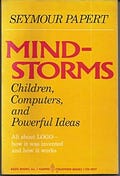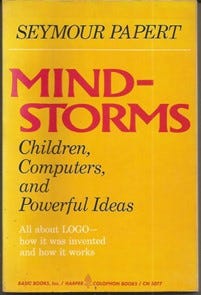CONTEMPORARY POLYMATHS - WHO IS SEYMOUR PAPERT?
In our upcoming book on The Art of collaborating with AI we develop the idea of the future belonging to modern-day polymaths who are able to apply interdisciplinary, diverse creative thinking in order to solve today’s complex problems.
We see this is the role that humans will be playing in the AI era. It will be about adding those subtle contextual big picture perspectives and nuanced insights to round out the fantastic outputs we will increasingly be receiving from AI.
In researching our book we came across so many excellent examples of Polymaths who throughout history are testimony to the importance of diverse creative thinking and we are currently showcasing some of these greats in our Polymathmind Substack.
And one of our personal favorites is Seymour Papert who way back in the 1980s had the vision to start seeing how increasingly our collaboration with computers would reshape the quality of our conceptual thinking. Papert died in 2016, so maybe he isn’t technically a contemporary polymath – but his ideas were, and still are, so powerful, we think he deserves an entry in our polymath hall of fame.
We gave ChatGPT some background to Papert’s work and the influence he has had and asked it to provide a summary - almost an homage - we could share with our Substack audience about this fantastic polymath. So this is a collective output from the three of us, showcasing the legend that was Seymour Papert
Mindstorms: Children, computers and powerful Ideas
In the 1980s, long before artificial intelligence became central to education, Seymour Papert laid down radical ideas about learning that are only now beginning to take root. In his groundbreaking book, Mindstorms: Children, Computers, and Powerful Ideas, Papert explored how children could learn through discovery, invention, and the creative use of technology.
A mathematician, computer scientist, and student of renowned psychologist Jean Piaget, Papert’s vision was unique: he believed that children, through engagement with computers, could grasp complex concepts and become empowered as independent thinkers. His ideas, seen as revolutionary in his time, have only become more relevant with today’s advancements in AI and personalized learning.
Papert’s vision of learning
Papert championed an idea he called ‘constructionism’, a theory arguing that people learn best when they actively build and create things that are meaningful to them. Rather than passively receiving knowledge, students could engage with ideas on a deeply personal level. Papert didn’t just want students to learn about maths or science; he wanted them to think like mathematicians and scientists, exploring ideas through hands-on, experiential learning. This emphasis on ‘learning by doing’ was exemplified by his work with the Logo programming language, a simple coding language designed to help children grasp complex concepts by controlling a small turtle on a computer screen.
In a world where most education still focused on memorization, Papert’s approach was a breath of fresh air, encouraging learners to approach problems with creativity and curiosity. His ideas went against the grain, but he was undeterred, believing that children had a natural ability to engage holistically with abstract concepts if given the right tools. Papert viewed computers as tools that could unleash this potential, allowing children to interact with ideas in ways that were intuitive and conceptual rather than procedural.
Interdisciplinary polymathic thinking and conceptual learning
Papert was a polymath who seamlessly wove together disciplines like mathematics, computer science, and psychology. This interdisciplinary approach helped him recognize that the act of thinking conceptually wasn’t limited to any one subject; instead, it was an interdisciplinary skill. By blending the sciences with human-centred psychology, Papert opened the door to a new way of understanding how we learn and interact with information. His work with Logo, for example, wasn’t just about teaching kids to code but was about helping them understand ideas like recursion, patterns, and logic in a tangible way.
This approach laid the foundation for today’s integrated educational tools that encourage students to approach problems holistically. Papert’s impact can be seen in modern educational software that uses AI to teach across disciplines, creating a learning experience that feels less like studying isolated facts and more like exploring interconnected ideas.
Foreshadowing the AI era
Papert’s work was prescient, laying the groundwork for today’s AI-enhanced learning tools. He envisioned a future where learning would be dynamic and personalized, much like the way AI systems now adapt to individual users. In his time, Papert had to build programs manually to respond to each student’s learning style. Today, this vision is realized on a much larger scale with AI-driven platforms that adapt in real-time to each user’s needs.
AI systems like ChatGPT, for example, echo Papert’s constructionist approach by dynamically generating responses based on vast amounts of information, learning and evolving in ways that are analogous to how Papert imagined children would learn by interacting with computers. In a sense, Papert was forecasting the capabilities of modern AI, recognizing the potential for computers to foster personalized, exploratory learning experiences decades before it became possible in practice.
The radical impact of Papert’s iconoclastic approach
In an era when educational systems focused heavily on standardized testing and memorization, Papert dared to question these conventions. He advocated for a future where education wasn’t about rote learning but about fostering true understanding through exploration. He saw children as natural ‘knowledge constructors’, as individuals capable of forming their own understanding of the world.
Papert’s iconoclastic approach is strikingly similar to the current shift toward AI-enabled, student-centred learning models, which give students the tools to explore concepts at their own pace. His view that children should be active creators of knowledge, not passive recipients, is a philosophy that AI can now help implement at a global scale. For Papert, the true aim of education was to cultivate thinkers, creators, and individuals who could tackle complex problems with innovative holistic solutions.
Papert’s legacy and influence on today’s thinkers
Papert’s influence is evident in the work of educators, technologists, and interdisciplinary thinkers who are pushing the boundaries of AI and learning. His ideas on how children can best learn through creativity and interaction laid the groundwork for modern educational theories and tools. Papert’s vision for a world where people engage deeply with ideas resonates with today’s approach to education and creative problem-solving.
In many ways, Papert was a visionary who foreshadowed the AI-driven era we are entering. His radical ideas continue to inspire an approach to learning that prioritizes exploration, imagination, and deep conceptual understanding, qualities that AI can now support in unprecedented ways. Papert would have been excited to see how today Chatbots can be deployed to provide personalized learning programmes.
A pioneering polymath and thought leader
To sum up, it is now more than 40 years since Seymour Papert predicted a future where technology would transform learning into a personal, exploratory journey. Today, as AI redefines education, Papert’s vision seems more relevant than ever. His approach to learning not only shaped educational philosophy but also anticipated how AI would eventually enable the kind of dynamic, personalized learning he dreamed of.
Papert’s legacy lives on as we continue to discover and apply his insights, creating a world where learning is not about memorizing facts but about exploring powerful ideas and discovering the world with curiosity and creativity.
“Do away with curriculum. Do away with segregation by age. And do away with the idea that there should be uniformity of all schools and of what people learn.” Seymour Papert





